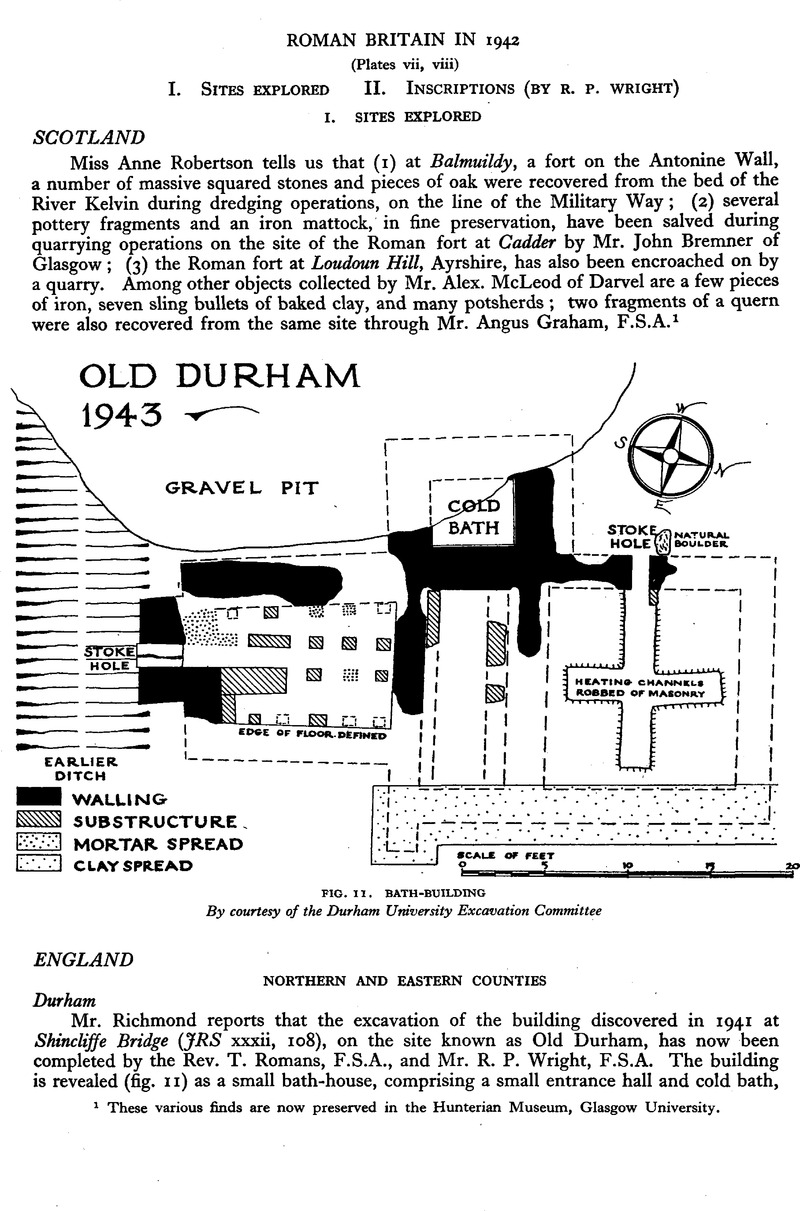No CrossRef data available.
Article contents
Roman Britain in 1942
Published online by Cambridge University Press: 24 September 2012
Abstract

- Type
- Review Article
- Information
- Copyright
- Copyright ©R. P. Wright 1943. Exclusive Licence to Publish: The Society for the Promotion of Roman Studies
References
1 These various finds are now preserved in the Hunterian Museum, Glasgow University.
2 Manchester Guardian, 22nd December, 1942.
3 Chester Arch. Soc. Journ. xxvii, pl. xxvi, site xxxvii.
4 W. T. Watkin, Roman Cheshire 221, no. 3, and Grimes, , Holt, Denbighshire (Y Cymmrodor xli, 1930), 137Google Scholar, mentioning an example found in London.
5 Curle, A Roman Frontier Post: The Fort at Newstead 266, fig. 35, 12 and 13; Miller, The Roman Fort at Balmuildy 78, plate 40, 8.
6 Mr. Graham Webster kindly sent information and the drawings illustrated in figs. 12, 13.
7 Information from Lt.-Col. I. Leslie; cf. Lynn Advertiser, 15th and 22nd May and 12th June, 1942, and Country Life, 3rd July, 1942.
8 Rev. Preb. S. H. Martin, Woolhope Club Trans. 1940, pp. xlvi and 53 ff.
9 Information from the Rev. G. A. Ward-Jackson of Lower Heyford to Mr. C. H. V. Sutherland.
10 Information from Miss Jocelyn Morris.
11 It is to be supposed that this road shows dark in contrast to the road running at right angles to it because the metalling has been all robbed away. The dark area across the top of the photograph between the lake and the remains of roads and buildings represents upcast thrown up when the lake was made ten years ago, burying all Roman remains in the area.
12 For no. 20 Tower Hill on the west, cf. JRS xxvii, 241.
13 Information from Mr. A. W. Everett, the finder, and Mr. Percy Morris.
14 Falconer, J. P. E., Proc. of Bath Branch of Somerset Arch. and Nat. Hist. Soc. 1942, 241 f.Google Scholar
15 A report will appear in the Wilts. Arch. Mag. 1.
16 For an excavated lime-kiln see Richborough Report iii (Soc. Antiqs. Research Reports) 36, pl. xlvi.
17 Here two small rectangular earthworks were noted by Williams Freeman, Field Archaeology … in Hampshire 1915, 308, 425.
18 Archaeologia xxviii, 453; Soc. Antiqs. Proc. xv, 78; Brit. Arch. Assoc. Journ. iii, 61 f., hence Vict. Co. Hist. i, 305; Pre-history of the Farnham District (Surrey Arch. Soc, 1939), 249.
19 The Roman enclosure on the Downs described by H. Sumner, Excavations on Rockbourne Down, Hampshire (1914) lies about three miles N of the new discovery.
20 Surrey Arch. Coll. xliii, 16, hence JRS xxv, 222.
21 Cf. Sussex Arch. Coll. lxxx, 75, fig. ix, 7. The drawing reproduced in fig. 14 was sent by Mr. Frere.
22 Plain and flanged tiles are recorded hereabouts by Heron-Allen, Selsey Bill 83.
23 The word larger in the last line of JRS xxxii, 114, is an error for later.
24 Preliminary Report by R. Geering and A. G. B. Chittenden in Arch. Cant. lv, 76 f.
25 When measurements are quoted the width precedes the height. The following abbreviations are used in addition to the usual ones, with superscript figures to denote the number of the series: AA = Archaeologia Aeliana; CW = Cumberland and Westmorland Transactions; EE = Ephemeris Epigraphica; LS = Bruce: Lapidarium Septentrionale; NCH = Northumberland County History; PSAN = Proceedings of the Society of Antiquaries of Newcastle upon Tyne.
26 CIL vii, 309; LS 738.
27 CIL vii, 483 (very inaccurate); EE ix, p. 579; LS 658; Haverfield, NCH x, 505, no. 38. We are indebted to Arch. Aeliana for the loan of the block used in fig. 15.
28 CIL vii, 1345.
28 CIL vii, 452; LS 541; Black Gate Cat. no. 4.
30 EE ix, 1141; AA3 vii (1911), 176Google Scholar, pl. facing p. 143.
31 CIL vii, 498; LS 539; Richmond and Wright, AA4 xxi (1943), 93–120Google Scholar. We are indebted to Archaeologia Aeliana for the loan of the block used in fig. 16.
32 Wilkinson, , PSAN4 x (1943), 89Google Scholar. For a map of the find-spot see AA4 xv (1938), 365Google Scholar.
33 Durham iii (1794), 318Google Scholar.
34 CIL vii, 1183, of which 1184 is only a second version; see AA 4 xvi, 257.
35 CW 2 xvi, 282.
36 Noticed by Mr. G. C. Dunning; information and drawing kindly sent by Mr. P. Corder.
37 Kraay, Antiqs. Journ. xxii, 219, who cites parallels for such tanks. We are indebted to the Society of Antiquaries for the block of plate viii.
38 Wroxeter 232.
39 Wroxeter 195, 233.
40 Wroxeter 199, pl. 47. CIL xiii, iii, 2, 10027, 105: one example from Mainz with this name.
41 Wroxeter 194.
42 Wroxeter 194.
43 Wroxeter 284, with fig. 42, no. A 2.
44 Professor R. Newstead kindly sent drawings and full details.
45 Grimes, , Holt, Denbighshire (= Y Cymmrodor xli, 1930), 211Google Scholar, fig. 59, nos. 12, 13.
46 See Haverfield, EE ix, 1274.




